If you want to build a successful blog, you need more than just great writing. You need a well-thought-out blog content strategy.
Blogging started as a way to let people share their voices online. But it has now become an important component of digital marketing.
A blog can generate leads, establish thought leadership in the industry, and create a strong brand.
Whether you’re a seasoned blogger or just starting, developing a comprehensive blogging strategy can significantly enhance your content’s reach and engagement. It’s also essential for standing out and attracting a loyal audience.
Disclaimer: If you buy any products through links on this site, I may earn a commission. But it doesn't make any difference to your cost, and it helps me keep this blog running. So you could always read my articles for free.
What is a blog strategy?
A blog content strategy is a blueprint for how you plan to launch and turn your blog into a success. It helps you steer your blog in the right direction and make sure that you achieve the goals you want to meet with your blog content.
A great blog strategy lies at the intersection of three key aspects – your readers, the products or services you sell, and your blog content.
Your blog content is the glue that connects the problems your target audience is facing with the solutions your business provides.
Why create a blogging strategy?
Over 7 million blog posts are being published daily. And majority of them fail to reach their audience. In fact, an Ahrefs study we found 96.55% of all web pages do not get any organic traffic.
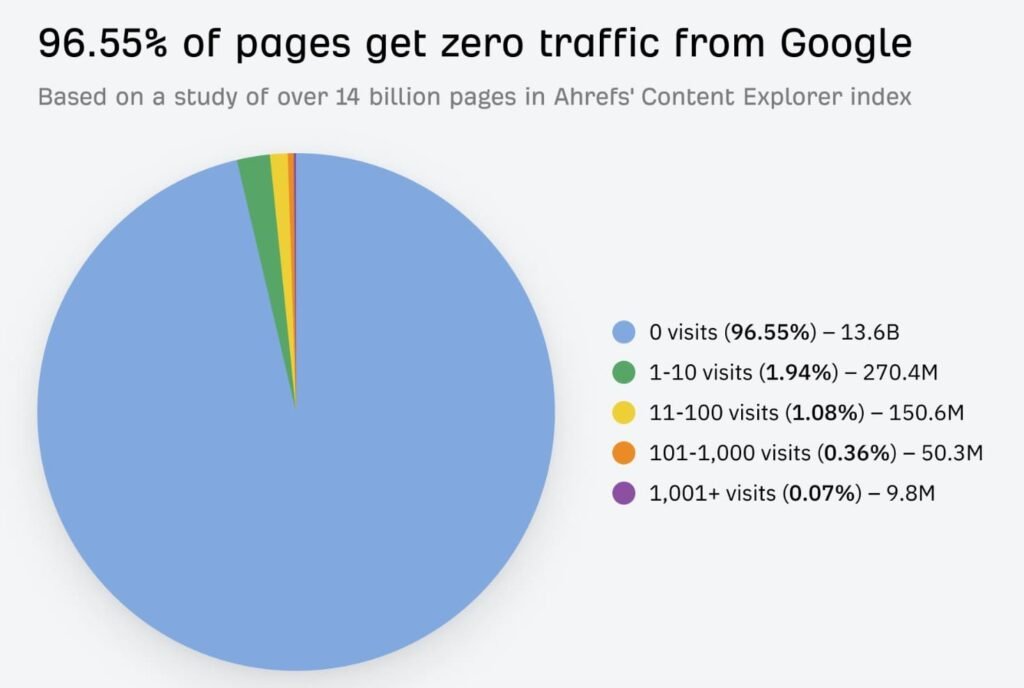
That’s why you must have a strong blog content strategy. It helps improve your traffic, engagement, and conversions.
In the absence of a clear plan, you are more likely to write blog posts without any concrete purpose in mind. As a result, you’ll end up damaging your blog’s potential to get qualified traffic and grow your business.
How to build a blog content strategy?
Here are the steps to create a blog strategy for your brand. So you can channel your efforts in the right direction and get more visitors to your website.
Determine your goals and KPIs
A blog can benefit you in many ways. So you need to identify the goals most important for you. What do you want to accomplish with your blog?
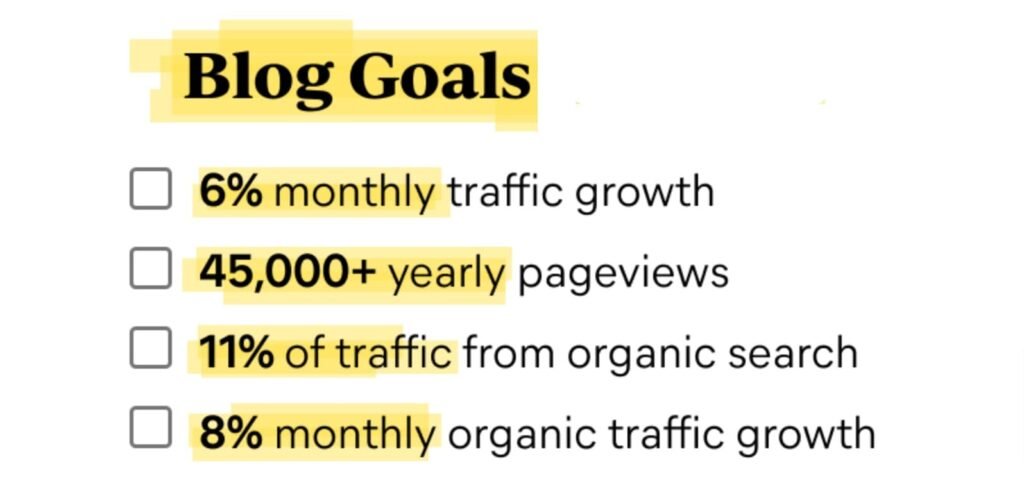
Having a clear sense of your objectives will ensure that you are making the right choices for the long-term, as well as for standalone blog posts. For example, the purpose of your blog could be to:
- Sharing your brand story
- Get more visitors to your website
- Generate more leads from your website
- Stay in touch with current customers with product updates and other news
- Educating your audience about problems and solutions in your space
Blogging can help you achieve one or more of these objectives. So you should have an agenda from the beginning.
Another reason to define your goals is to identify the performance metrics you need to monitor and analyze. For example, if your aim is to get more eyeballs, you’ll want to measure data such as page views and organic traffic.
Determine your blog’s value proposition and target audience
Why does your blog exist? What’s the purpose of your blog posts? Your responses to these questions are essential for shaping your blog content strategy.
Take AdEspresso, for instance. Its purpose is to be the best resource for marketing professionals who want to maximize the ROI of their social media campaigns.
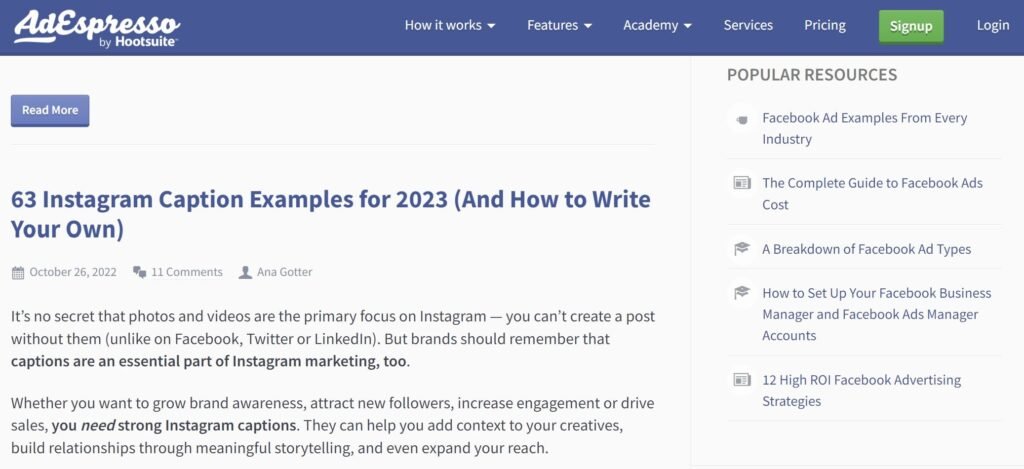
Or take this blog that you’re reading right now. With this blog, my goal is to help people with the best tools and strategies to excel at work and business.
You want to define your “why” right from the outset. This will help you align all the components of your blog content strategy toward a common goal.
Analyze your competitors
Competitor research is invaluable for your blog content strategy. You want to know what’s working for your competitors. So you can take inspiration from it. And you want to know what’s not working for them. So you can learn from their mistakes and failures.
By analyzing your competitors, you can uncover information such as the keywords they’re targeting, the types of content they’re creating, and the channels they’re using to promote blog posts.
It all starts with identifying your competitors. One way to do this is to find companies that sell products and services similar to yours. Once you’ve identified these brands, you can check their best-performing content using an SEO tool such as Ahrefs’ Site Explorer.

This data can help you select the keywords and topics that you might want to blog about.
Another way to identify your competitors is to find websites that target the same keywords as you do, even if their products and services don’t match yours.
You can do this with the Ahrefs Keywords Explorer. Just enter your keyword and head over to the Traffic Share by Domains report.
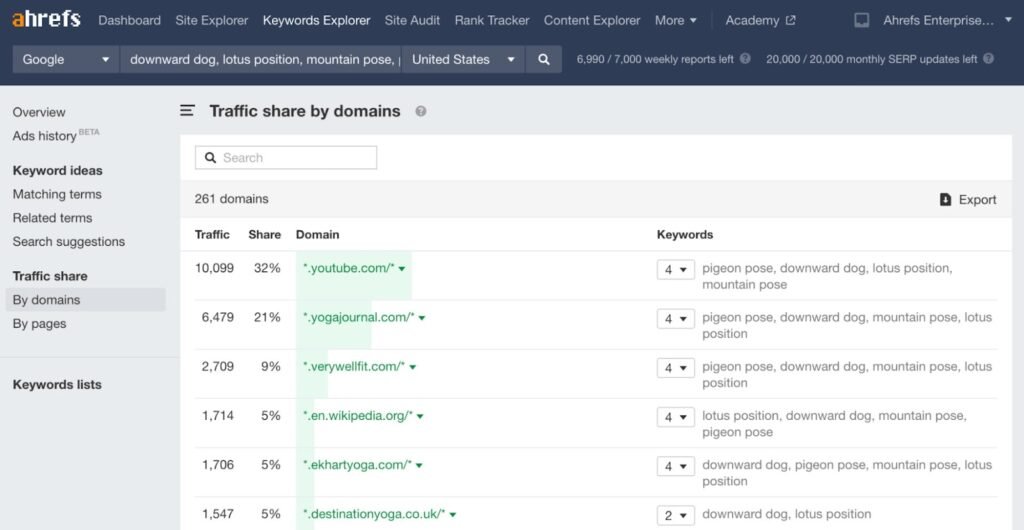
Apart from discovering what your competitors are writing about, also try to figure out what they’re not writing about.
Are there any topics or themes they’re not addressing? This would be your opportunity to grab some of the online traffic share from them.
Conduct keyword research
Whatever the end goal of your blog, you want your blog posts to rank higher in search engine result pages. So you can reach your target audience.
That means your competitors’ target keywords are not the only ones you should target. You also need to know what other keywords people are searching for in your industry.
Keyword research tools such as Ahrefs, Semrush, and Moz can help you identify these keywords, and build a list of your target keywords. This way, you’ll know what you and your team should be writing about in the coming months.
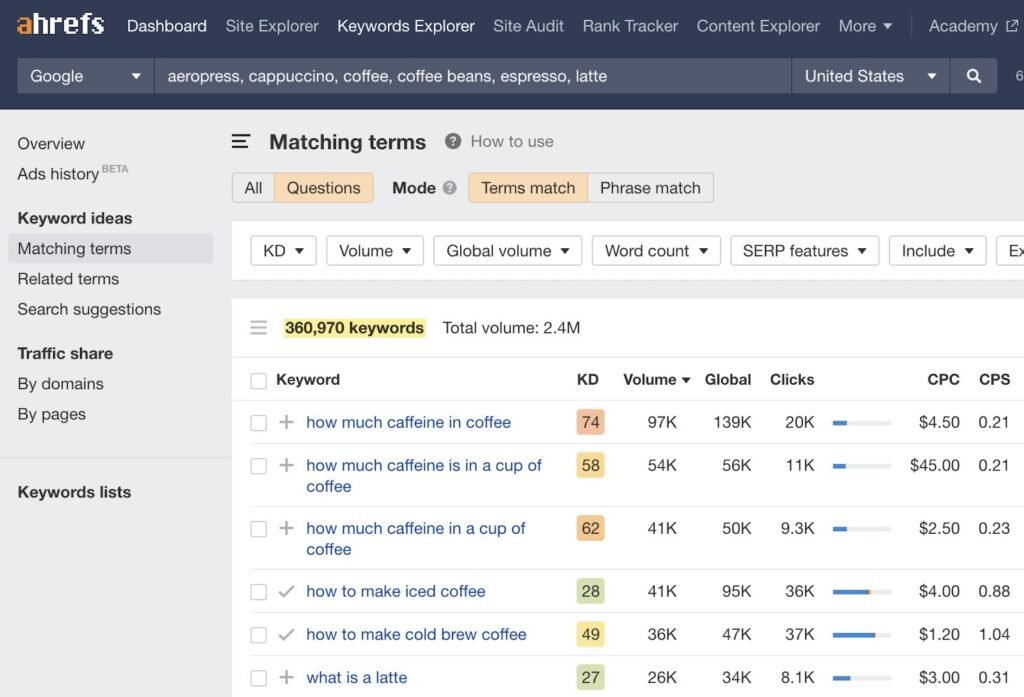
Keyword research begins with entering a seed keyword. These are the broad, high-level topics related to your niche and business. For example, if your blog is about personal finance, your seed keywords could be:
- money management
- make money
- save money
- personal finance
- investment tools
- financial planning
So entering any of these keywords into a keyword research tool will give you a list of thousands of additional keywords. From there, you can select the ones you want to write about.
Prioritize blog post topics
If you have followed the steps above, I am sure you have a lot of ideas for blog posts for now. But you can’t start with any random topics.
You want to start generating traffic and leads as soon as possible. So you should prioritize topics that are most likely to succeed. That’s what it means to follow a blog content strategy.
How do you identify those topics? By considering the following metrics:
Monthly search volume – The more people search for a given keyword, the more traffic you have a chance of attracting.
SEO difficulty – Most well-known SEO tools show you a difficulty score for each keyword. The higher this score, the more competition you have for that keyword, and the lower the chance of ranking at a high position. So you want a low difficulty score.
Monetization potential – How closely is the keyword connected to your business, products, or services?
You should start with keywords and topics that align the most with these three metrics.
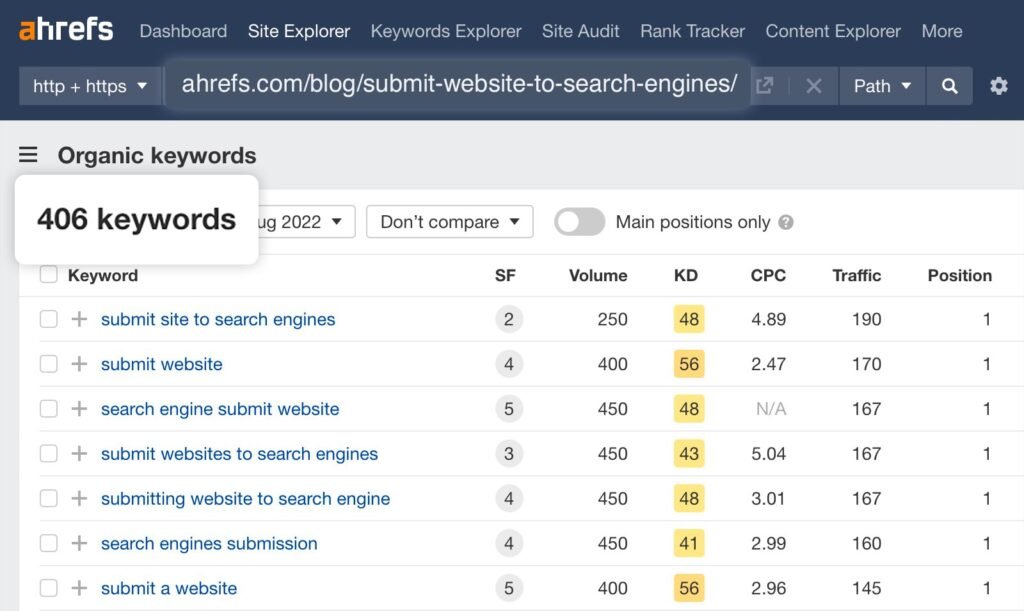
You can use any modern keyword research tool to get this data. In Ahrefs Keywords Explorer, for example, you can view both search volume and keyword difficulty for your target keywords.
Plan your blog’s brand identity
Your blog is not just a blog. Like any other business, it’s also a brand. And you need rules to define a consistent and memorable brand identity for your blog. There are two key components of your blog’s brand identity: imagery and voice.
To take care of your brand’s imagery, you need guidelines that establish its visual identity. These include the rules surrounding the photos, fonts, and colors you will use on your blog, as well as on other platforms where you promote your blog.
When it comes to voice, you need to establish guidelines for how you want your blog posts to sound, along with the writing and formatting rules that will apply to all your blog posts. These are also called editorial guidelines or style guides.
For example, think about whether you want your content to sound:
- Humble and friendly
- Helpful and informative
- Excited and bubbly
- Inspiring and cheerful
- Professional and formal
- Humorous and goofy
Besides that, your writing rules will determine formatting, spelling (British vs. American), capitalization, readability, and more.
You need to be specific about these rules because without a consistent style of branding and writing, your audience will be less likely to form a positive perception of your brand, and to remember this perception.
Create your blog content calendar
If you have a lot of blog posts to write and publish, you need to plan far ahead in a way that editors and writers have enough time to draft, review, and approve the pieces according to your deadlines. That’s where an editorial calendar comes in.
A content calendar is a way to visualize the blog posts you plan to publish in the coming months. It lets you coordinate content creation and publishing across your team members.
There are many ways to create and use such a calendar as part of your blog content strategy. For example, you can use a tool like Planable to view all your scheduled blog posts at a glance. And you can drag and drop the topics to move them to different dates in the calendar.
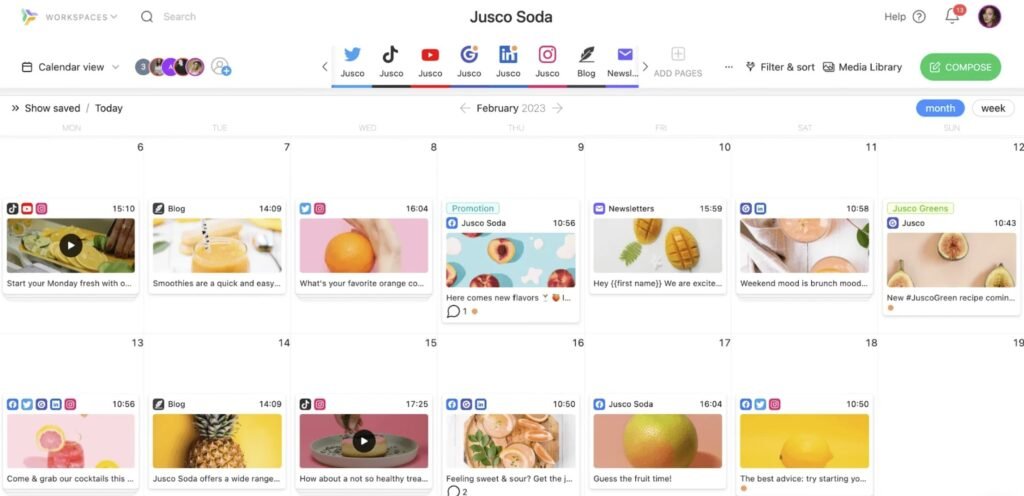
If you’re writing blog posts as part of a team, this software has many collaboration features such as comments, notes, and approval requests.
Start producing blog content
Once you’ve got your topics lined up, it’s time to outline your posts. An outline helps you organize your thoughts and ensures your writing stays focused.
It should start with a catchy introduction, lay out the main points in a logical order, and end with a strong conclusion. This structure will keep your readers engaged and make your writing process smoother.
Now, let’s get to writing. Start by drafting your content without worrying too much about perfection. The first draft is all about getting your ideas down on paper. Don’t let the pursuit of the perfect sentence slow you down. You can always polish your work later.
After you’ve got your draft, take a break before you edit. Coming back to your work with fresh eyes can help you spot errors and areas for improvement that you might have missed initially.
Edit for clarity, grammar, and flow. Tools like Grammarly or Hemingway can be invaluable here, helping you refine your content and make it more readable.
Don’t forget to optimize your posts for SEO. Use relevant keywords naturally within your content.
And make sure to include meta descriptions, alt texts for images, and internal links to other relevant posts on your blog. This will help your blog rank better in search engines and attract more readers.
Decide your blog promotion channels
Effective blog promotion is a crucial part of your blog content strategy. Without promotion, even the best blog posts can go unread.
Promotion also helps build your brand and establish your authority in your niche. Plus, engaging with readers through promotion fosters a loyal community around your blog.
So this part of your blog strategy is about choosing the right channels and strategies to distribute your blog posts. Knowing your audience’s habits and preferences will guide you in this area. Here’s a laydown of the most popular blog promotion strategies:
Social media: Social media is a powerful tool for blog promotion. Each platform has its strengths. Facebook is great for building a community and sharing a mix of content types. Twitter is perfect for quick updates and engaging in conversations.
Pinterest can drive significant traffic, especially if your blog has a visual component like recipes, fashion, or home decor. Don’t just post links to your blog—engage with your audience, share valuable content, and join relevant groups and discussions.
Email marketing: Building an email list allows you to reach your audience directly. Send out newsletters with links to your latest posts, exclusive content, and special offers. Encourage visitors to your blog to subscribe by offering something valuable, like a free eBook or a discount on your products.
SEO (Search Engine Optimization): While it’s more of a long-term strategy, optimizing your blog posts for search engines can significantly increase your organic traffic. Use relevant keywords, optimize your meta descriptions, and ensure your site is mobile-friendly.
Guest posting: Guest blogging can also help you reach new audiences. Write articles for other blogs in your niche with a link back to your own blog. This not only helps with SEO but also introduces your blog to a wider audience.
Online advertising: Google Ads, Facebook Ads, and sponsored posts on social media can help you target specific audiences and drive traffic to your blog quickly.
By understanding your audience and leveraging a mix of these promotion channels, you can effectively grow your blog’s readership and engagement.
Keep experimenting and analyzing your results to find the perfect combination that works for you.
Measure performance and refine blog strategy
Determining how and how often you’ll audit your blog’s performance is another key step to building a wholesome blog strategy.
By keeping an eye on how your content is doing, you can understand what works and what doesn’t, allowing you to adapt your strategy for better results.
Tools like Google Analytics can provide insights into various metrics, such as page views, bounce rates, and average time spent on your site.
Pay attention to which posts are getting the most traffic and engagement. Are there particular topics or types of posts that consistently perform well? This information is gold when planning future content.
Comments and social media interactions also offer valuable feedback. What are your readers saying? Are they asking questions, leaving positive comments, or sharing your posts?
Engaging with your audience helps you understand their needs and interests, which you can then address in your blog.
Don’t forget to monitor your blog’s SEO performance. Check which keywords are driving traffic to your site and see how well your pages rank in search engine results.
Tools like SEMrush or Ahrefs can help you with this. If certain keywords are performing well, consider creating more content around those topics.
Once you’ve gathered your data, it’s time to adapt your strategy. If a particular type of post is popular, plan more content in that style. If certain topics are underperforming, figure out why.
Maybe the content needs to be more engaging, or perhaps it’s not being promoted effectively. Adjust your promotion tactics if needed, trying different social media platforms or posting at various times to see what works best.
Regularly setting aside time to review your blog’s performance ensures you’re not just producing content blindly. It’s about working smarter, not harder.
By continuously analyzing and adapting your strategy, you keep your blog relevant and engaging, ensuring long-term success and growth.
Over to you: blog content strategy
By now, you understand the importance of knowing your audience, planning your content, and promoting it effectively. Remember, your strategy is a living document—don’t be afraid to tweak and refine it as you go.
Consistency and quality are your best friends, so keep creating valuable, engaging content that resonates with your readers. Stay flexible, monitor your performance, and adapt as needed.
With a solid strategy in place, you’re well on your way to building a successful blog that stands out and keeps your audience coming back for more.
Did I miss anything? Did you try these steps? Do you have any questions or comments? Share your thoughts below in the comments section.






Developing a content plan involves understanding your audience, setting clear goals, and choosing the right distribution channels. A strategic approach ensures that content remains relevant and impactful.
Very well explained blog on content strategy. This blog breaks down content strategy in such a clear and actionable way.